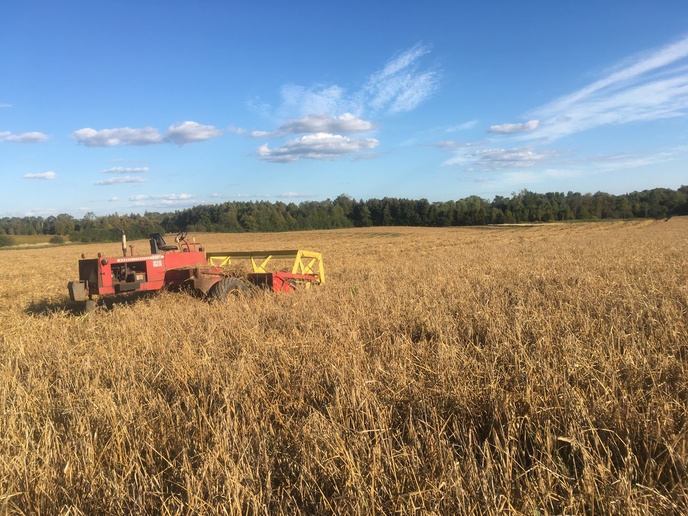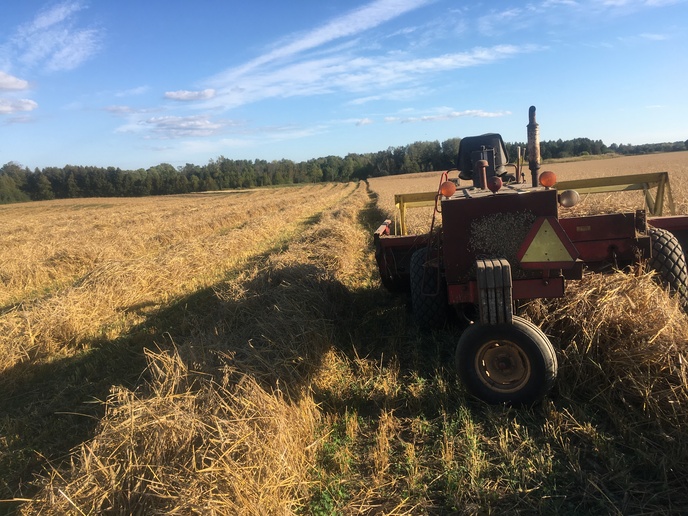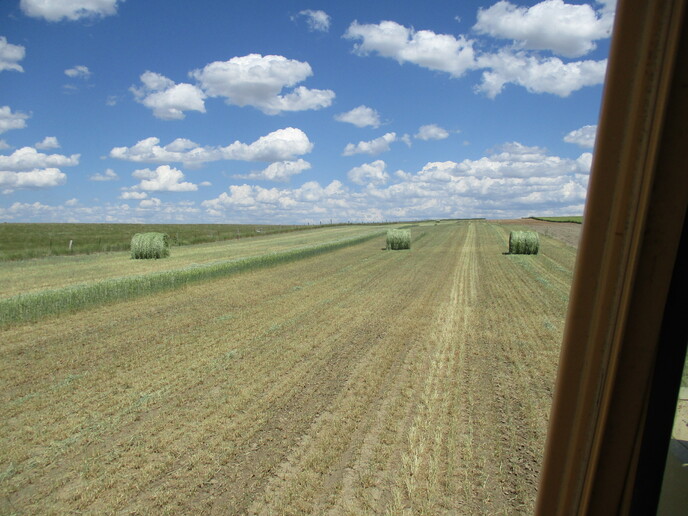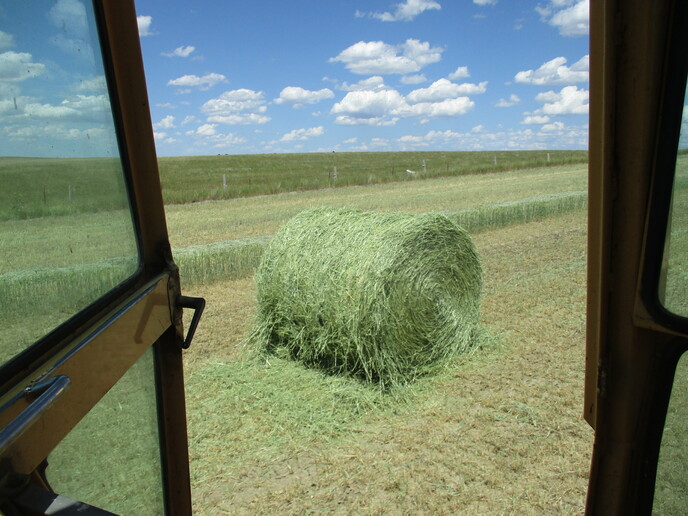I see posts here where people are talking about swathing grains such as barley and wheat. Here in my part of New York grains like those are just combined. One step operation. I guess I just understand the process ! Just trying to learn about something I have no clue about ! Farmers around here do have swathers, but are usually referred to as windrowers and are used to cut hay crops. What are the advantages of swathing grain crops ?
You are using an out of date browser. It may not display this or other websites correctly.
You should upgrade or use an alternative browser.
You should upgrade or use an alternative browser.
- Thread starter 300jk
- Start date
If you have small grain that is ripening unevenly, or has patches of weeds, swathing will allow it all to dry out and be combinable. Dessicating the crop with roundup has taken over the idea of swathing.
Downside of swathing, if the weather turns out wet, you crop can sprout and become useless, especially barley and wheat.
Downside of swathing, if the weather turns out wet, you crop can sprout and become useless, especially barley and wheat.
There is typically some loss if using a pull type swather. If the swather is 12 ft which was common, then swaths were run over at the corners. Typically a field would be cut round and round, and a corner would be a 90 degree turn and the tractor would run over the previous swath as the corner was made. With 15 or 16 ft cut swathers, there would usually be enough room for the tractor to make a 90 degree turn and miss the previous swath. I've run 10, 12, 15 and 16 ft swathers in small grains and have driven over a lot of swaths at corners. This was much improved when the self propelled swathers came out.
I have seen where a field had a fence around it and the first cut around the field was run backward so the out end of the swather would be close to the fence. The tractor wheels and inner swather wheel would be running in uncut grain creating lots of lose. The second swath would be the first in the "right" direction and a piece of folded tin would be placed over the sickle in the same width as the swath so the tin would slide over the previous swath. If that portion of the sickle was not covered, it would cut the previous swath into shreds causing even more loss. Even waiting to cut next to the fence as the "last round" still caused some uncut grain to be lost when opening a field.
Hope that makes some sense.
I have seen where a field had a fence around it and the first cut around the field was run backward so the out end of the swather would be close to the fence. The tractor wheels and inner swather wheel would be running in uncut grain creating lots of lose. The second swath would be the first in the "right" direction and a piece of folded tin would be placed over the sickle in the same width as the swath so the tin would slide over the previous swath. If that portion of the sickle was not covered, it would cut the previous swath into shreds causing even more loss. Even waiting to cut next to the fence as the "last round" still caused some uncut grain to be lost when opening a field.
Hope that makes some sense.
Brendon-KS
Well-known Member
- Location
- Goessel, KS
Swathing of small grains and canola is mostly something that happens up north, especially in Canada. With the short growing season the threat of snow before the crops are ready to be combined is a problem. So, the crop is swathed with still too wet to combine which hastens the ripening. This is especially popular with canola since, being an oil seed, it can lay in the swath until spring with relatively little loss if winter comes earlier than expected. If a standing canola field was left until spring there wouldn't be anything left to harvest. Years ago almost everything up north was swathed but any more most small grains are direct cut unless there is a compelling reason to swath it.
Bruce from Can.
Well-known Member
- Location
- Woodville, Ontario, Canada
My swather doing spring grain last fall.


Some years lots of spring grain is swathed, other years very little swathing is done. Truth be told, very little in the way of Oats or Barley are grown local to me anymore, as it doesn’t fit well into the 3 crop rotation practice of local cash crop farmers. And there are fewer and fewer small time farmers each year.


Some years lots of spring grain is swathed, other years very little swathing is done. Truth be told, very little in the way of Oats or Barley are grown local to me anymore, as it doesn’t fit well into the 3 crop rotation practice of local cash crop farmers. And there are fewer and fewer small time farmers each year.
Russ from MN
Well-known Member
- Location
- Bemidji MN
I only remember dad straight combining a couple of times, everything had to be swathed for the straw to dry, I think that's the reason! I think the seed was ripe for picking, but the straw was still too green to go through the combine, if you wait for the straw to dry standing the seed would be fallen off. Oats, barley, wheat, and flax were our main crops. And for a few years, timothy seed, but that didn't work out so well.
I’m starting to understand the concept. When growing up the dairy next door had two Massey swathers or windrowers like we called them . A lot like yours. Two skinny drive tires on each side, and the tail wheels with weights on the back. They haven’t had them out in years since they bought a New Holland with a cab !
That part of it must just be different geographic locations ! Old time hog farmer next to our place used to pick a head and rub it between his hands. If the hulls came off easy it was ready to combine. Straw was raked then baled within a day or two. That was the way it was for many years while I was growing up.
I can’t imagine leaving a crop on the ground all winter ! Seems like there would be a lot of waste and rot before you could get to it in the spring ! Just different areas I guess. With our winter temps going from 40 degrees Fahrenheit to minus 10 with snow and rain I can’t see how any crop could stand a chance !
Adirondack case guy
Well-known Member
Most of what you call "windrowers" here in the NE had conditioner rolls in them. Not suitable for swathing small grain. The conditioner rolls have to be removed to swath small grains. There were multi crop machines built like the one that Bruce pictured that the headers had draper belts on the cutter platform that carried the crop to the center of the head and dropped it into narrow conditioner rolls for making hay, and the conditioner roll assy, could be detached from the head to swath small grains.-----Loren
Weeds. In this neck of the woods[NWWI] hard to grow small grains w/o them getting weedy. a real disaster to combine direct. You can take a field that looks like a total failure, swath it, let lay for a few days and can thresh out some pretty decent grain plus will usually make some pretty respectable straw. IF you don't get caught in a wet spell. geese love to sit on the swaths and poop all over them. tried to combine direct many years ago with a gleaner K. had to unload onto the ground with the auger swung back cause it was so wet and heavy that it wouldn't go up the whole auger. I had a JD 800 swather but when that died I used a NH479 haybine with most of the rubber gone off one roll plus the rolls are blocked open a 1/2". Run with the dew on and no shatter problem.
It's funny this topic should pop up on here now, as I have been thinking of the same thing lately. No one around here ever swaths their small grain, it's all direct cut. Have never seen in person any of these machines you are talking about. My dad is old enough that he started out shocking the grain, then the guy with the thresher would come around threshing the shocks at all the farms around. All the neighbors would get together at each farm to get the job done.
Every year lately, as the oats get closer to being ready, I keep an eye on the weed situation and wonder if swathing could work here given our rather wet conditions most of the time (just not this year, got our first rain this week since end of May - was very dry here). Dad always says no, but if we can make dry hay why not swath the oats to get weeds dried out? Oats are one of the crops you can't use roundup on as a harvest aid, not labelled and if you do use it, it makes the grain very light weight.
Paul
Every year lately, as the oats get closer to being ready, I keep an eye on the weed situation and wonder if swathing could work here given our rather wet conditions most of the time (just not this year, got our first rain this week since end of May - was very dry here). Dad always says no, but if we can make dry hay why not swath the oats to get weeds dried out? Oats are one of the crops you can't use roundup on as a harvest aid, not labelled and if you do use it, it makes the grain very light weight.
Paul
Case Nutty 1660
Well-known Member
Here we raise a lot of forage grain for cattle feed,, this year with the drought we have normal hay production is down from 1 1/2 ton per acres average to less than 1/4 ton per acre,, I normally get 2 1/2 to 3 ton per acre in grain hay looks like I am getting 1-1 1/2 ton in the grain this year,, I do windrow alfalfa if cutting for seed and have windrowed a few grain crops a couple times but do most direct cutting of grain, the bales in the pics are a hay barley i grow




Majorman
Well-known Member
- Location
- Scarning, Norfolk, England
I used to be deeply involved with combine harvesters of all makes back in the day and was always intrigued by the Massey 750 and 760's combines of the 1980 era that had a decal on the side telling the operator to remove certain deflector plates "when combining in snow". I was once giving a talk to the Agricultural Engineers Association and one of the other speakers was the head of combine development from MF in Canada. I asked him about the decal and he explained how, in Canada, they swathed the crop, allowed the snow to cover it, then picked up the swath with the snow on it with the combine. The snow was so cold it did not "wet" the crop. He invited me to come to Canada and drive a demonstration combine in the snow but other things got in the way and I never made the trip, something I regret now.
MarkB_MI
Well-known Member
- Location
- Motown USA
Back in Colobraska, it was a regular occurrence for our winter wheat to get hailed out. My dad would sometimes disk the wheat under and put in a crop of millet. But, as others have said, it could be a gamble whether the millet would be dry enough to combine before first snowfall. So we would swath it, then combine it with a pickup attachment. I remember one year we ended up combining it the following spring after turning the windrows; I don't think we got much out of that crop.
Brendon-KS
Well-known Member
- Location
- Goessel, KS
This only works with canola. Since the seed is full of oil it is a lot more "weatherproof" than other grains. But, it must be in a windrow to last over winter; otherwise it would all shatter out of the pods. Leaving it over winter is definitely not something that is desirable but sometimes the weather leaves no choice.
rockyridgefarm
Well-known Member
I windrow my rye. Really does wonders for feeding it through the combine. Dries up the weeds. Reduces shatter loss. Makes for more even feeding. My neighbor started asking me to windrow his oats about five years ago. I now windrow for 3-5 others as well. I have a tired old Hesston 6650 with 15 foot head. Last year in a moment of crazy, I called up a macdon dealer to price a m150 with 15 foot disc mower conditioner head and 13 foot Draper head. I passed at the $199k price.

Bruce from Can.
Well-known Member
- Location
- Woodville, Ontario, Canada
Ya I’ll bet that price tag nearly blew your mind.
Folks I worked for swathed for years starting with a modified grain binder. When I worked there I cut several hundred acres of hay and grain each summer with an IH 175 swather. Moved up to a Massey 775(I think) for the last year or so I was there. We were probably the last in the area to swath. It really worked well to swath a piece of oats that were underseeded to hay as the alfalfa would be all dry and roll through the combine with no issues.
Similar threads
- Replies
- 14
- Views
- 1K
- Replies
- 18
- Views
- 3K
We sell tractor parts! We have the parts you need to repair your tractor - the right parts. Our low prices and years of research make us your best choice when you need parts. Shop Online Today.
Copyright © 1997-2024 Yesterday's Tractor Co.
All Rights Reserved. Reproduction of any part of this website, including design and content, without written permission is strictly prohibited. Trade Marks and Trade Names contained and used in this Website are those of others, and are used in this Website in a descriptive sense to refer to the products of others. Use of this Web site constitutes acceptance of our User Agreement and Privacy Policy TRADEMARK DISCLAIMER: Tradenames and Trademarks referred to within Yesterday's Tractor Co. products and within the Yesterday's Tractor Co. websites are the property of their respective trademark holders. None of these trademark holders are affiliated with Yesterday's Tractor Co., our products, or our website nor are we sponsored by them. John Deere and its logos are the registered trademarks of the John Deere Corporation. Agco, Agco Allis, White, Massey Ferguson and their logos are the registered trademarks of AGCO Corporation. Case, Case-IH, Farmall, International Harvester, New Holland and their logos are registered trademarks of CNH Global N.V.
Yesterday's Tractors - Antique Tractor Headquarters
Website Accessibility Policy

